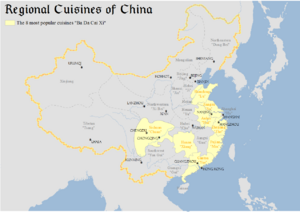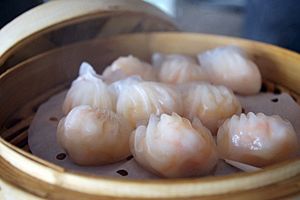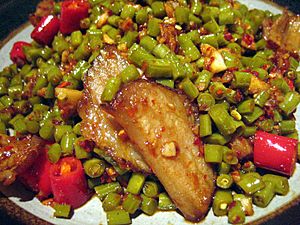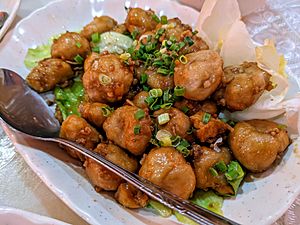Chinese regional cuisine facts for kids
China is a huge country with many different regions. Because of this, Chinese food isn't just one type of cooking! It's actually many different styles, called Chinese regional cuisines. These styles come from different provinces and even from Chinese communities around the world.
Many things make these food styles unique. For example, what ingredients are available in a region, the weather, the land, history, cooking methods, and how people live all play a part. One style might use lots of garlic, while another might focus on seafood.
For instance, Jiangsu cuisine often uses slow cooking methods like braising and stewing. But Sichuan cuisine is known for baking. In Shanghai, a special treat is the Chinese mitten crab, which lives in local lakes. You might also know famous dishes like Peking duck and dim sum, which are popular all over the world!
Different regions use various ingredients and cooking methods. This creates a wide range of flavors and textures. Many traditional foods also use old ways to keep food fresh. These include drying, salting, pickling, and fermenting.
Contents
Eight Great Traditions
Long ago, people talked about the Four Great Traditions of Chinese food. These were Chuan, Lu, Yue, and Huaiyang. They represented the west, north, south, and east of China. Today, this list has grown to the Eight Great Traditions. Let's explore them!
Guangdong (Cantonese) Cuisine
Guangdong, or Cantonese, cuisine is famous for letting the natural taste of the food shine. Chefs use very little sauce. It's best known for dim sum, which are small, tasty dishes. Dim sum became very popular in Hong Kong in the early 1900s.
These bite-sized foods are made using traditional cooking methods like frying, steaming, stewing, and baking. Dim sum lets you try many different dishes in small portions. Some popular dim sum items include rice rolls, lotus leaf rice, turnip cakes, buns, and jiaozi-style dumplings.
The Cantonese way of eating, called yum cha, combines these dim sum dishes with drinking tea. "Yum cha" literally means "drink tea."
Sichuan Cuisine
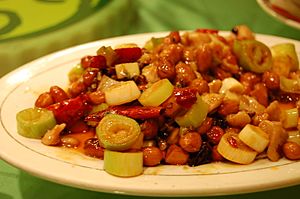
Sichuan cuisine comes from the Sichuan Province in southwestern China. It's famous for its strong and bold flavors. This food is often very spicy and tingly! This comes from using lots of garlic, chili peppers, and a special ingredient called Sichuan peppercorn.
Other important ingredients in Sichuan food include peanuts, sesame paste, and ginger. If you like spicy food, you'll probably love Sichuan dishes!
Anhui Cuisine
Anhui cuisine comes from the Huangshan Mountains region in China. It's a bit like Jiangsu cuisine. However, Anhui food uses less seafood. Instead, it focuses on many different local herbs and vegetables.
Anhui province has lots of fresh bamboo and mushrooms. So, these ingredients are often found in their dishes.
Shandong Cuisine
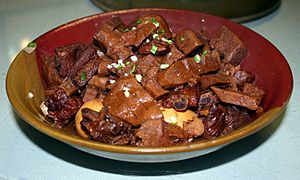
Shandong cuisine is also known as Lu cuisine. It was a very important part of the food served to the emperors in the Ming dynasty and Qing dynasty. This food style is found all over North China.
Lu cuisine dishes are known for being fresh, salty, crisp, and tender. Chefs in Shandong are very good at making clear broths and creamy soups. Shandong cuisine uses many different cooking methods and lots of seafood. Some typical dishes are braised abalone, braised sea cucumbers, sweet and sour carp, and Dezhou chicken.
Fujian Cuisine
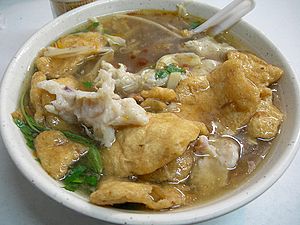
Fujian cuisine, also called Hokkien cuisine, is shaped by Fujian's location near the coast and its mountains. Foods from the forest, like edible mushrooms and bamboo shoots, are also used.
Chefs in Fujian are skilled at slicing ingredients. This helps to make the seafood and other foods taste, smell, and feel even better. Fujian cuisine is often served in a broth or soup. Common cooking methods include braising, stewing, steaming, and boiling.
Jiangsu Cuisine
Jiangsu cuisine is a big part of Chinese cooking. It includes styles from cities like Huai'an, Yangzhou, Nanjing, Suzhou, and Zhenjiang. It's especially popular near the lower part of the Yangtze River. Huaiyang cuisine, which is one of the Four Great Traditions, is a style of Jiangsu cuisine.
Some popular dishes from Jiangsu cuisine include Jinling salted dried duck (Nanjing's most famous dish) and crystal meat (pork heels in a bright, brown sauce).
Hunan Cuisine
Hunan cuisine is famous for its hot and spicy flavor. It also has a fresh smell and deep colors. Common cooking methods include stewing, stir-frying, pot-roasting, braising, and smoking.
Because the region grows a lot of food, there are many different ingredients for Hunan dishes. In China, Hunan cuisine is called Xiāngcài. Some typical dishes are steamed smoked meat and stewed fish. Besides being spicy, Hunan cuisine, especially in western Hunan, also likes sour flavors. That's why different kinds of pickles are popular there.
Zhejiang Cuisine
Zhejiang cuisine comes from the cooking styles of the Zhejiang region. The dishes are not oily. Instead, they have a fresh, soft flavor with a gentle smell.
This cuisine has at least four main styles, each from a different city:
- Hangzhou style: Known for many different dishes and using bamboo shoots.
- Shaoxing style: Specializes in poultry (like chicken) and freshwater fish.
- Ningbo style: Focuses on seafood.
- Shanghai style: A mix of different Zhejiang styles, also very famous for its dim sum.
Other Regional Cuisines
China has many other regions and groups with their own special dishes and styles. These include places like Macau and Taiwan.
Hainan Cuisine
Hainan cuisine comes from the cooking styles of the people in Hainan Province in China. The food is lighter, less oily, and has milder flavors than food from mainland China. Seafood is very common because prawns, crabs, and different kinds of fish are easy to find there.
Hakka Cuisine
Hakka cuisine is the cooking style of the Hakka people. You can also find it in parts of Taiwan and in countries where many Hakka people live. This cuisine focuses on the texture of the food. It also uses a lot of preserved meats and vegetables.
Mongolian Cuisine
Mongolian hotpot is very famous in China. It's a popular dish even with the Han Chinese people.
Tibetan Cuisine
Tibetan cuisine is usually eaten with bamboo chopsticks. This is different from other Himalayan foods, which are often eaten by hand. Small soup bowls are used. Wealthier Tibetans used to eat from bowls made of gold and silver!
Xinjiang Cuisine
The food of Xinjiang shows the many different groups living in the region, especially Uyghur cuisine. Some special ingredients include roasted mutton, kebabs, roasted fish, and rice. Because many people in this area are Muslim, most of the food is halal.
Yunnan Cuisine
Yunnan is the most diverse province in modern China, with many different types of land, people, and cultures. So, it naturally has a wide variety of food!


